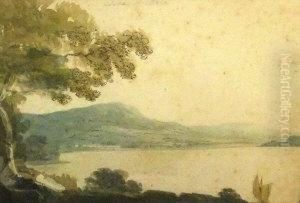John Baverstock Knight Paintings
John Baverstock Knight was an English landscape painter active during the 19th century, known for his picturesque depictions of the English countryside, particularly those featuring bodies of water. He was born in 1779, and not much is documented about his early life, including his artistic training. However, his works suggest that he had a profound understanding of light and atmosphere, which he skillfully incorporated into his landscapes.
Knight's paintings often exhibit a serene quality, with a preference for rural scenes that present an idyllic view of nature. His compositions typically feature rivers, lakes, or coastal scenes, with a remarkable attention to the reflection of light on water and the detailed rendering of foliage and vegetation. This focus on water scenes may have been influenced by the works of other English landscape painters of the time, such as John Constable and J.M.W. Turner, although Knight maintained his own distinct style.
Throughout his career, Knight exhibited his works at various prestigious institutions, including the Royal Academy of Arts in London. Despite the recognition he received during his lifetime, Knight did not achieve the same level of fame as some of his contemporaries. Nevertheless, his paintings are appreciated for their tranquil beauty and delicate treatment of natural light.
John Baverstock Knight passed away in 1859. His legacy survives through his contributions to the tradition of English landscape painting. His works continue to be of interest to collectors and art historians who study the evolution of landscape art in Britain. While not a household name, Knight is recognized as a skilled artist whose work captures the essence of the English countryside during a period when the appreciation for natural beauty was increasingly celebrated in art.







